
by Stephen Greer | Nov 13, 2020
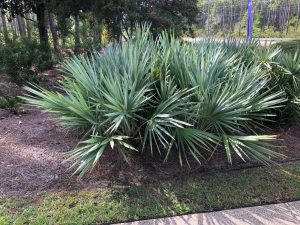
Photo credit: Stephen Greer, University of Florida/IFAS Extension
Landscapes are an ever-changing setting that can be fun to view as the seasons come and go. We all have differing ideas of what an exceptional landscape should be. The point to always keep in mind is what you and your family like. Are you considering the Florida-Friendly Landscaping elements? You always want to keep a healthy, attractive environmental sound landscape. This brings many interesting design concepts to the table.
The kitchen table is exactly where a landscape design needs to begin. My dad was just the opposite, he would receive or buy plants on impulse. Load up all these three-gallon plants, take them home and plant without consideration the long-term growth, color combinations, time of bloom and many more topics. He just loved working in the yard and growing plants.
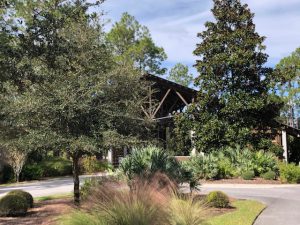
Photo Credit: Stephen Greer, University of Florida/IFAS Extension
There are basic principles of landscape design that are used as a guide. While I may stray from them from time to time, I always return to these principles. Just keep in mind that a landscape is an ever-changing living setting that we will always work to improve. The visual elements are based on what you see first when you enter a setting and are usually the vibrant high impact plants that may include bright bloom color, size of plant, focal plantings, leaf size and others. The other side of the visual is the subtle presence of low impact plants with softer colors, small leaves, lower growing plant size. This visual group often is planted en mass with a flow of plants to create a calming effect for the visitors to your landscape.
When the form of the plant is being considered, there are several points to keep in mind. Will it have a three-dimensional impact in the landscape setting? Is the landscape a small backyard or a one-acre open setting? What are the maintenance requirements of the plant(s) as they mature in size? A large tree can dominate a small area, but it may be just what is needed for shade with low plantings around it. In a large setting, multiple large trees may be needed to create a focal point. I have seen some wonderful tree alleys that help in directing the flow of the landscape down drives, walks, and paths. These forms should be considered for all plants in the landscape including, trees, shrubs, groundcovers and even hardscapes.
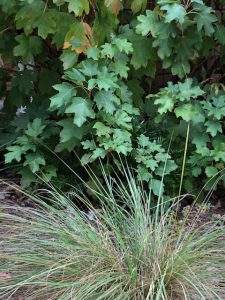
Photo Credit: Stephen Greer, University of Florida/IFAS Extension
Up next is the texture of the plant(s). Are you looking for large and coarse or small, “softer” leaves? You may find finely textured plants along paths or at entry areas to steps, softening the hardscape of the steps. Are the large leaved plants open and airy, allowing light to flow through? Large coarse leaved plants may be found at the back of landscape beds with fine textured smaller plants in front creating a three-dimensional look or even used as a focal point to pull the gaze of the eye to a determined location.
Color in the landscape has just as much impact as the plant texture, size and form. Color can bring a bold or a soft statement. The color is often thought of from blooms, but leaves too change in color with the seasons, from a fresh new bright green, purple, red or other colors in the spring to deeper, more mature colors as summer comes in. Trunks can also bring unique colors to the landscape from subtle yellows to cinnamon.
There are so many things to think about when creating a long-term vision for your landscape. Many options come in the decisions that will need to be made. Do your research and always contact your local Extension office for more information!
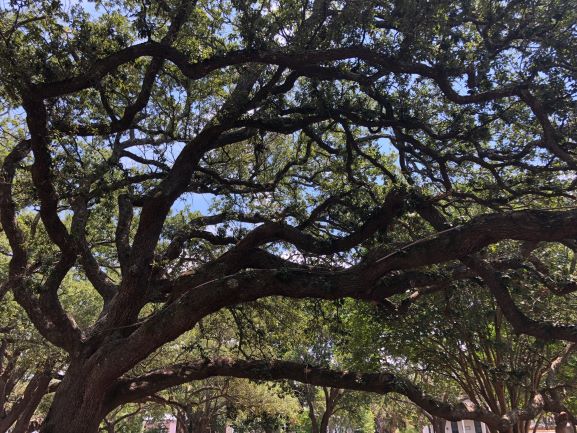
by Carrie Stevenson | Oct 21, 2020
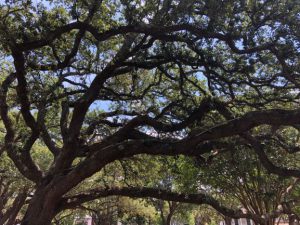
Even healthy live oaks need maintenance and occasional trimming to stay safe. Photo credit: Carrie Stevenson, UF IFAS Extension
After storms, Extension agents are routinely asked about whose responsibility it is to maintain a tree along a property line. This becomes particularly important in a situation where a property owner’s tree or branch falls and causes damage to their neighbor’s home or possessions.
To clarify this often contentious issue, reference to legal experts is necessary. In a series of publications called “The Handbook of Florida Fence and Property Law,” two attorneys and a University of Florida law student explain several statutes that give us direction. The section on “Trees and Landowner Responsibility” goes into further detail and cites case-law, but for ease of reading it is summarized below.
Situation 1: Removing a healthy tree on a shared property line.
If two neighbors share a tree on their property line and one of them wants to remove it, the adjoining landowner must give their permission. Removing trees can impact property value, heating/cooling bills, or aesthetic value. Without a neighbor’s consent, the landowner cutting down a tree can be legally liable for damages.

Hurricanes can have serious impacts on trees in their path. Photo credit: Carrie Stevenson, UF IFAS Extension
Situation 2: Responsibility for overhanging branches and roots.
A big storm hits your neighborhood, with tons of rain, wind, and lightning. You wake up in the morning and see that a large branch fell from your neighbor’s tree and crushed your kids’ basketball goal. If branches from the neighbor’s tree were otherwise healthy, they are not responsible for any damages resulting from the tree. If it was dead, however, and their negligence contributed to the branch falling, they will be responsible for damages.
Keep in mind that if the neighbor’s tree/branches/roots are in good health but interfering with something in your yard, you may trim them at your own expense. The same goes for your tree hanging in their yard, so while it’s not required, it’s always good to have a conversation first to let them know your plans.

After Hurricane Ivan, this tree’s root system completely uprooted and destroyed and adjacent fence. Photo credit: Beth Bolles, UF IFAS Extension
Situation 3: Hurricane Sally blew your neighbor’s tree over and into your yard.
Just like the situation with branches and roots, the same principle goes for an entire tree falling on adjoining property—if the tree was alive, it’s the responsibility of the person whose yard it fell in. If it was dead when it fell, it’s the responsibility of the tree’s owner to pay for damages.
In a complicated situation involving property damage, the saying, “good fences make good neighbors” only goes so far. Be sure to note the health of your trees throughout the year and trim back dead or dying branches. If you see serious decay or have concerns about a tree’s health, contact your county Extension office or a certified arborist. Finally, if the circumstances aren’t easily determined, be sure to contact a licensed attorney and/or your insurance company for direction.
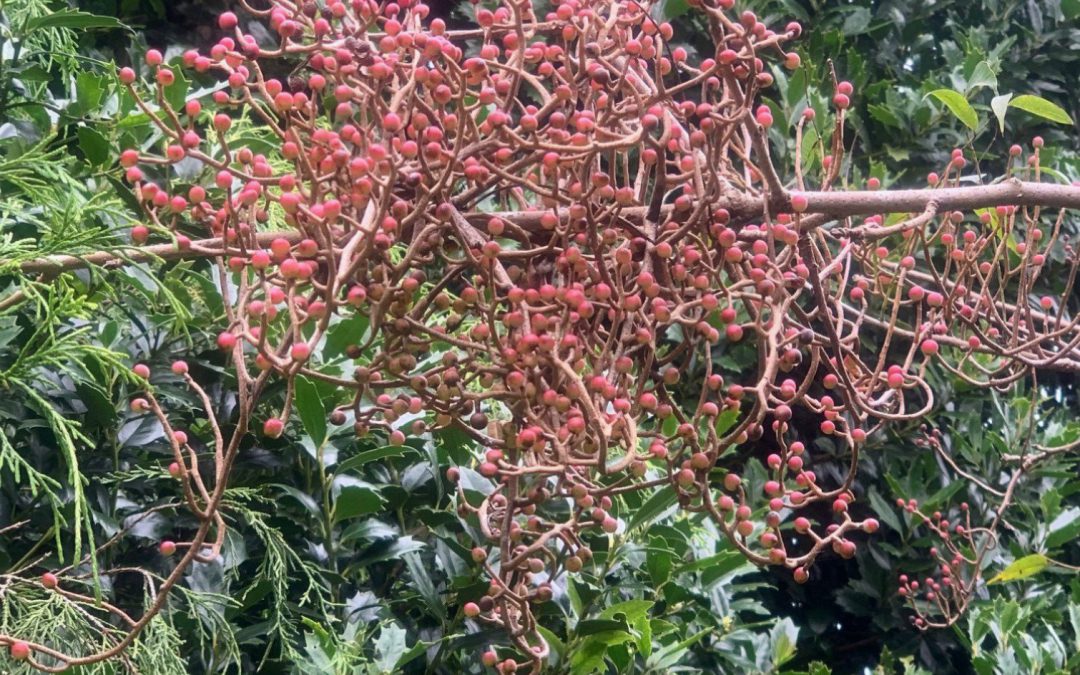
by Beth Bolles | Oct 21, 2020
Many people often request a recommendation for a small tree that will be suitable for their landscape and one to consider is the Chinese Pistache, Pistachia chinensis. Although not a native tree, Chinese Pistache does not have invasive potential so it can make a suitable option for both commercial and residential landscapes.
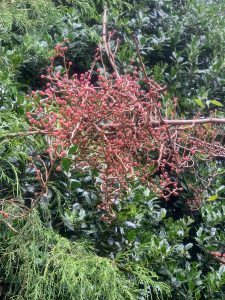
Berries also offer nice fall color. Photo by Beth Bolles, UF IFAS Extension Escambia County
The best features of Chinese Pistache are the fall color it offers with orange leaves, followed by clusters of salmon berries. It will lose its leaves as days shorten but you can enjoy the textured bark during the winter season. Compound leaves offer interest as well during the spring and summer. Adding some medium to fine textured foliage plants under and around trees will provide a nice landscape display.
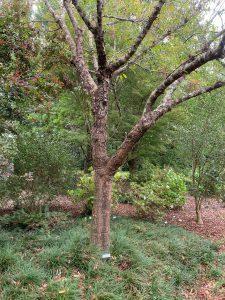
Chinese Pistache has been an attractive feature in the Escambia County Demonstration Garden for over 20 years. Photo by Beth Bolles, UF IFAS Extension Escambia County
A positive feature of Chinese Pistache is that once it is established, it is tolerant of drought. Expect trees to be about 25 to 30 feet in height with a 20 to 25 foot spread. Each tree will have it own unique branch structure and some pruning will be required when trees are young to develop strong connections. You may plant as a full sun tree to provide a little dappled shade for your garden or use as an understory tree in partial shade.

by Larry Williams | Oct 1, 2020
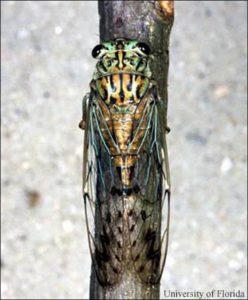
Adult cicada on tree branch, Photo credit: Lyle Buss, UF Entomologist
“What is that noise,” asked the visitors to Middle Georgia when I was a teenager. They were visiting during the summer from El Paso, Texas. I asked, “What noise?” The reply, “That loud noise in the trees.” I responded, “Oh, those are cicadas.’ There are sounds that are so common that sometimes you quit hearing them.
Before the visitors left for El Paso, I made sure to show them the brown, dry shells (exoskeletons) of cicadas that are not difficult to find attached to the trunk of a Georgia pine tree during summer. Cicadas leave their nymph exoskeletons on the trunks of trees and sometimes shrubs when they shed them to become mature flying adults.
You may not have ever seen a cicada but you’ve undoubtedly heard one if you live in Florida. These insects make a loud buzzing noise during the day in the spring and summer. Male cicadas produce their distinctive calls with drum-like structures called timbals, located on the sides of their abdomens. The sound is mainly a calling song to attract females for mating.
Cicadas spend most of their life underground as nymphs (immature insects) feeding on the sap of roots, including trees, grasses as well as other woody plants. They can live 10 or more years underground as nymphs. In some parts of the United States, there will be news reports of when periodical cicadas are expected to emerge from the ground. Periodical cicada species mature into adults in the same year, usually on 13- or 17-year life cycles. Their numbers can be enormous as they emerge, gaining much local attention. However, cicada species in Florida emerge every year from late spring through fall and in much smaller numbers as compared to the periodical cicadas.
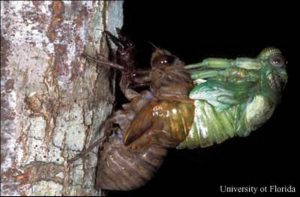
Cicada emerging from exoskeleton, Photo credit: Lyle Buss, UF Entomologist
There are at least nineteen species of cicadas in Florida, ranging from less than a ¼ inch to over 2 inches in length. Some people might be frightened by their size and sounds but thankfully cicadas don’t sting or bite. They are a food source for wildlife, including some bird species and mammals.
Very rarely, I’ll have someone ask about small twigs from trees found on the ground as a result of the female cicada’s egg-laying process. But because this is usually such a minor issue with practically no permanent damage to any tree, cicadas really aren’t considered to be a pest of any significance in Florida.
For more information on cicadas, contact the University of Florida Extension Office in your County. Or visit the following UF/IFAS web page. https://edis.ifas.ufl.edu/in602
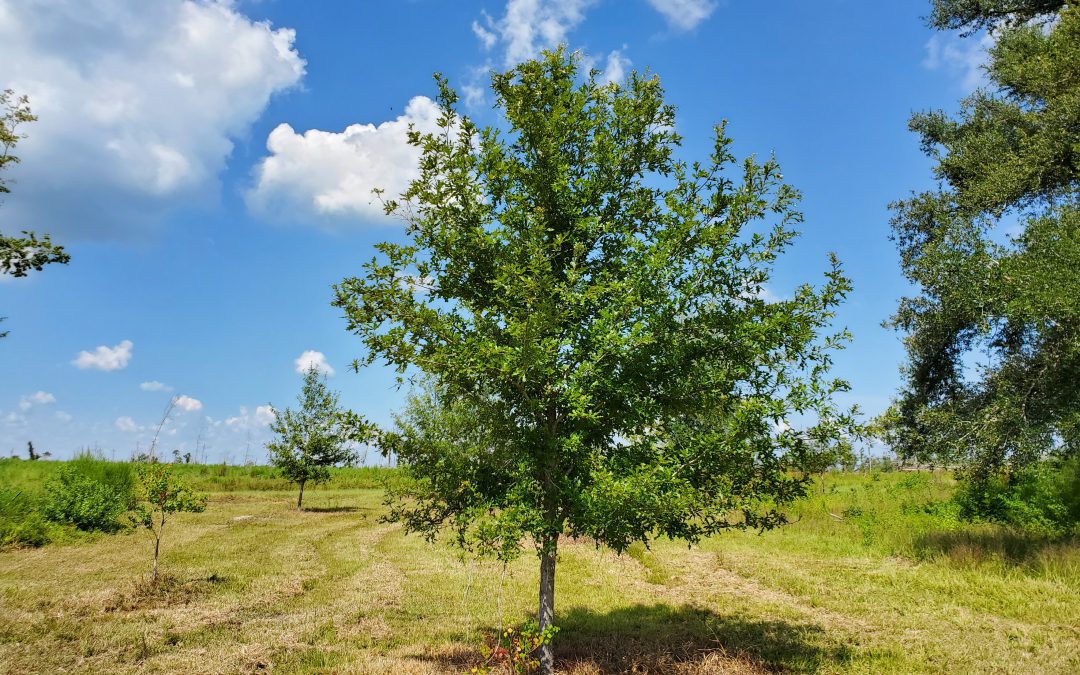
by Daniel J. Leonard | Sep 8, 2020
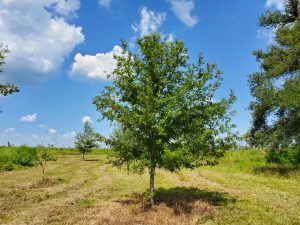
7 year old Overcup Oak (Quercus lyrata) on the edge of a wet weather pond in Calhoun County. Photo courtesy of Daniel Leonard.
Haunting alluvial river bottoms and creek beds across the Deep South, is a highly unusual oak species, Overcup Oak (Quercus lyrata). Unlike nearly any other Oak and most sane people, Overcups occur deep in alluvial swamps and spend most of their lives with their feet wet. Though the species hides out along water’s edge in secluded swamps, it has nevertheless been discovered by the horticultural industry and is becoming one of the favorite species of landscape designers and nurserymen around the South. The reasons for Overcup’s rise are numerous, let’s dive into them.
First, much of the deep South, especially in the Coastal Plain, is dominated by poorly drained flatwoods soils cut through by river systems and dotted with cypress and blackgum ponds. These conditions call for landscape plants that can handle hot, humid air, excess rainfall, and even periodic inundation (standing water). It stands to reason our best tree options for these areas, Sycamore, Bald Cypress, Red Maple, and others, occur naturally in swamps that mimic these conditions. Overcup Oak is one of these hardy species. Overcup goes above and beyond being able to handle a squishy lawn, it is often found inundated for weeks at a time by more than 20’ of water during the spring floods our river systems experience.
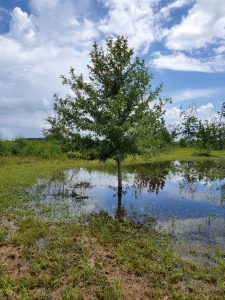
The same Overcup Oak thriving under inundation conditions 2 weeks after a heavy rain. Photo courtesy Daniel Leonard.
The species has even developed an interesting adaptation to allow populations to thrive in flooded seasons. Their acorns, preferred food of many waterfowl, are almost totally covered by a buoyant acorn cap, allowing seeds to float downstream until they hit dry land, thus ensuring the species survives and spreads. While it will not survive perpetual inundation like Cypress and Blackgum, if you have a periodically damp area in your lawn where other species struggle, Overcup will shine.
Overcup Oak is also an exceedingly attractive tree. In youth, the species is extremely uniform, with a straight, stout trunk and rounded “lollipop” canopy. This regular habit is maintained into adulthood, where it becomes a stately tree with a distinctly upturned branching habit, lending itself well to mowers and other traffic underneath without having to worry about hitting low-hanging branches. The large, lustrous green leaves are lyre-shaped if you use your imagination (hence the name, Quercus lyrata) and turn a not-unattractive yellowish brown in fall. Overcups especially shines in the winter, however, when the whitish gray, shaggy bark takes center stage. Overcup bark is very reminiscent of White Oak or Shagbark Hickory and is exceedingly pretty relative to other landscape trees that can be successfully grown here.
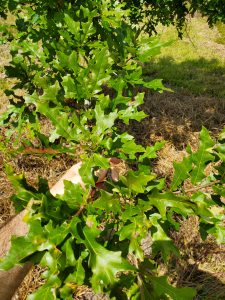
Overcup Oak leaves in August. Note the characteristic “lyre” shape. Photo courtesy Daniel Leonard.
Finally, Overcup Oak is among the easiest to grow landscape trees. We have already discussed its ability to tolerate wet soils and our blazing heat and humidity, but Overcups can also tolerate periodic drought, partial shade, and nearly any soil pH. They are long-lived trees and have no known serious pest or disease problems. They transplant easily from standard nursery containers or dug from a field (if it’s a larger specimen), making establishment in the landscape an easy task. In the establishment phase, defined as the first year or two after transplanting, young, transplanted Overcups require only a weekly rain or irrigation event of around 1” (wetter areas may not require any supplemental irrigation) and bi-annual applications of a general purpose fertilizer, 10-10-10 or similar. After that, they are generally on their own without any help!
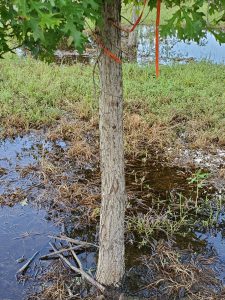
Typical shaggy bark on 7 year old Overcup Oak. Photo courtesy Daniel Leonard.
If you’ve been looking for an attractive, low-maintenance tree for a pond bank or just generally wet area in your lawn or property, Overcup Oak might be your answer. For more information on Overcup Oak, other landscape trees and native plants, give your local UF/IFAS County Extension office a call!



















